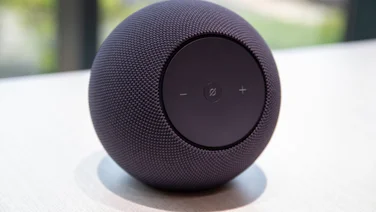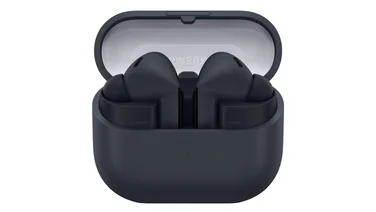To help us provide you with free impartial advice, we may earn a commission if you buy through links on our site. Learn more










- Good sound quality for the size
- Smart home hub features are great
- Alexa still works well
- Expensive
- Alexa light ring not well placed
Black Friday deal: Save £10 on the new Echo Dot Max
It's only just been released but the latest Echo speaker is already on offer. It's still a bit too expensive in our opinion, so you might want to hang on to see if the price drops further closer to the big day itself.
£90 was £100
Amazon rules the roost when it comes to smart speakers and the Echo Dot is the most popular of the lot. It’s easy to see, then, why Amazon might choose to target the Echo Dot for an upgraded version, rather than just producing another mid-range effort. It’s jumping on the Echo Dot bandwagon.
That means that the Echo Dot Max can make some bold claims: it’s the best sounding Echo Dot speaker, with two speaker drivers inside for the first time ever, comes with a fresh design, while purported to be designed for Alexa+ – the AI-enhanced version of Amazon’s voice assistant.
But the price says different. The Echo Max launches closer to the price of the old Echo 4th Gen (now discontinued), so that repositioning isn’t quite as simple as it first appears.
What do you get for the money?
The Echo Dot Max is slightly larger than the Echo Dot – some 8mm wider – but sticks to the spherical Echo design that has dominated since first appearing in 2020. There’s a slight twist in the form of a concave section in the front for the controls, while and the plastic base that crept up the rear of the speaker previously has been dropped.
It looks like a small Death Star and that’s a good look. The mesh that wraps the device is more textured mesh than it was before and it comes in three colours – Graphite (pictured here), Amethyst and Glacier White.
The controls on the front allow users to mute the mic and change the volume, and there are tap gestures to pause music or snooze an alarm. Inside is a 0.8in tweeter and 2.5in woofer, replacing the single 1.73in driver in the Echo Dot 5th Gen.










There are no physical connections except the power, but Wi-Fi 6E is supported, alongside Bluetooth 5.3, as well as Zigbee, Thread and Matter – and it offers eero Built-in, to seamlessly extend an existing eero network.
Voice control is via Alexa, while setup and further settings can be found in the Alexa app. That includes an equaliser to tinker with the sound output, as well as the options to group the Echo Dot Max or form a stereo pair if you have two of these speakers.
In the future, the Echo Dot Max will also be able to form part of Alexa Home Theater, working with the Fire TV Stick 4K, Fire TV Stick 4K Max or Fire TV Cube to create a home cinema system. At the time of writing, that hadn’t yet been enabled.
What did we like about it?
Sound quality is the real star for the Echo Dot Max and it’s easy to say that this is the best sounding Echo Dot so far. Is it really an Echo Dot, though? That’s the question.
The separation of the woofer and tweeter makes a significant difference to the sound quality that this speaker offers, leading to a cleaner sound, with a noticeably wider soundstage than the older Echo Dot.
Some of this comes from clever driver placement within the sphere: the Echo Dot Max woofer fires upwards and slightly rearwards, while the tweeter fires forwards and down, and that spreads and separates the audio nicely. It’s easy to listen to and the boosted bass makes for greater richness.










Voice control is good and I think that Alexa remains the best assistant in the home. There’s definitely a formulaic approach to getting what you want from Alexa, but I found the Echo Dot Max delivered swift responses and had no problem hearing me. Many people will just use Alexa for controlling music and setting timers – and that could be enough for them.
Alexa+ – which I’ve used in the US but isn’t available elsewhere – will take Alexa to another level, but at the time of testing, it’s not available in the UK for the Echo Dot Max.

Over the past decade Alexa has been around, the service has expanded to make it possible to connect just about any smart home system. The Echo Dot Max includes support for Zigbee, Matter and Thread, so those building a connected smart home system can directly control devices from this speaker, or expand on a network to make sure other devices remain connected.
But Alexa’s real skill has been behind the scenes, linking everything up to make the dream of a coordinated smart home possible. While Google Home offers much the same, this is the real advantage of diving into an Alexa ecosystem – through things such as Routines, it does so much more than just let you set kitchen timers.
The Echo Dot Max is an easy access point to that system for those who want a speaker that just sounds a little better, while not taking up much space in whatever room you drop it into.










What could it do better?
My biggest gripe with the Echo Dot Max comes back to that question I posed of whether this is an Echo Dot at all, because it sits so close to the old standard Echo in terms of price. The kicker is the Echo Dot Max doesn’t sound as good as the Echo 4th Gen – it has fewer drivers and it’s smaller overall as well – and that also makes me feel like it should be £20 cheaper.
While the sound quality is great for the size – and enhanced over the Echo Dot – it will distort as you turn the volume up and that means where and when you can use it is limited. It’s wonderful in my office, but take it into my open plan kitchen for a party and it gets a little lost. That’s where the power of the new Echo Studio really comes through – and that would be my preferred speaker for filling larger spaces.










The Echo Dot has lacked physical connections since the last generation, so if you’re looking to pipe-in high quality audio, then you’re out of luck. And while the Death Star design looks great, the light weight of the speaker (it’s 505.3g) means that it often moves when you press the buttons. That doesn’t happen so readily on the Echo Studio due to its weight – and it didn’t happen at all with the old design.
And the light ring that has characterised Alexa on Echo speakers from day dot – excuse the pun – has now moved to around that concave section on the front of the speaker. That means you can’t see it unless you’re standing in front of the speaker. Previously, it was a ring around the base of the speaker (or on the top for older generations) and both offered great glanceability. That’s now gone, and it’s less convenient as a result.
Should you buy the Echo Dot Max?
The Echo Dot Max achieves its mission of elevating the Echo Dot experience: it sounds better and that’s the real takeaway; for many Alexa fans, that will be reason enough to buy. The absence of Alexa+ at the time of writing is something of a drawback, but with that service expected in 2026, the Echo Dot Max should get more appealing with time.
It’s the price difference that’s really tricky to contend with here
As ever, though, I’d wait for Amazon’s customary price reductions before buying – there’s no need to pay full price for any Echo device when Amazon’s sales are so frequent and price drops so predictable.

The Echo Dot Max (right) next to the standard 5th gen Echo Dot
















